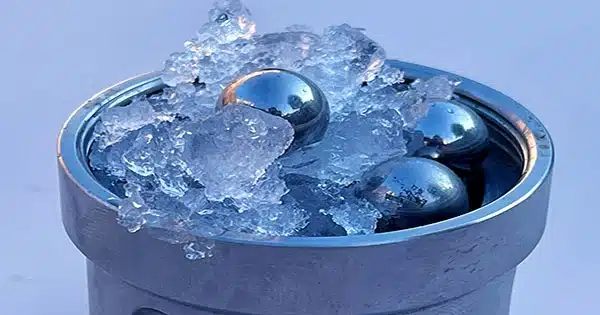Water ice can develop from a wide range of molecularly level formations. Despite having relatively similar overall appearances, various configurations of solidified water can respond and perform differently depending on their characteristics.
One such phase is cubic ice, the topic of continuing scholarly discussion. Some scientists have even questioned whether it does exist. Ice that has traditionally been thought to be primarily cubic may be a blend of other, more typical kinds of ice.
Scientists from the Chinese Academy of Sciences (CAS) and other institutions claim to have produced reasonably pure cubic ice – or Ice Ic, to give it its technical name – in the new research. The results could have far-reaching consequences in fields ranging from climate change to materials science.
“[T]here has long been debate about whether water can freeze to form cubic ice – a currently undescribed phase in the phase space of ordinary hexagonal ice,” the researchers write in their article.
The ice phase is determined by the environmental circumstances that exist when it develops, such as temperature and pressure. The water molecules and ice crystals in cubic ice are organized in a cubic arrangement, hence the name.
Scientists from the Chinese Academy of Sciences (CAS) and other institutions claim to have produced reasonably pure cubic ice – or Ice Ic, to give it its technical name – in the new research. The results could have far-reaching consequences in fields ranging from climate change to materials science.
“[T]here has long been debate about whether water can freeze to form cubic ice – a currently undescribed phase in the phase space of ordinary hexagonal ice,” the researchers write in their article.
The ice phase is determined by the environmental circumstances that exist when it develops, such as temperature and pressure. The water molecules and ice crystals in cubic ice are organized in a cubic arrangement, hence the name.
The researchers examined ice crystallizing on 2D graphene sheets at extremely low temps using a method known as transmission electron microscopy (TEM). Using electron rays and their reactions, TEM can photograph things at the molecular level.
A lesser quantity of the more regular, hexagonal ice (Ice Ih) developed alongside the predominantly cubic ice during the formation process. The formation of two ice stages may provide scientists with a hint as to why cubic ice hasn’t appeared as expected in previous tests, the team claims.
The researchers claim that the heterogeneous nucleation of pure-phase ice Ic under the present circumstances is completely demonstrated by the observed pure-phase single crystals.
According to the researchers, no transitions between cubic and hexagonal ice were seen, and the cubic ice remained steady under the experiment’s 102 Kelvin temperature. (-171 degrees Celsius or -276 degrees Fahrenheit). That consistency has occasionally been a problem.
This experiment demonstrates that cubic ice is more likely to develop at extremely low temps, well below what your home freezer can handle. The study of ice in the high atmosphere, ice used for cryopreservation, and other topics depending on our ability to comprehend it.
The case is not yet concluded, and the researchers admit that more study is needed to prove the presence and properties of cubic ice, as well as how its defects may impact its behavior.
“The investigation of the structure and dynamics of defects in ice Ic provides a critical step toward understanding ice plasticity at the molecular level,” the researchers write.














